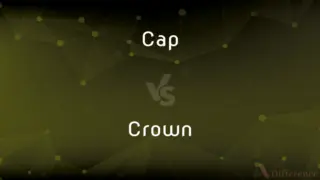Dianthus vs. Carnation — What's the Difference?
By Tayyaba Rehman & Maham Liaqat — Updated on April 1, 2024
Dianthus is a genus of flowering plants, while carnation, a member of this genus, is known for its symbolic and ornamental value.

Difference Between Dianthus and Carnation
Table of Contents
ADVERTISEMENT
Key Differences
Dianthus refers to a broad genus of plants that includes over 300 species, known for their beautiful flowers and distinctive fragrance. Carnations, or Dianthus caryophyllus, are a specific species within this genus, celebrated for their richly colored, ruffled flowers and their use in floral arrangements and symbolism.
While all carnations are dianthuses, not all dianthuses are carnations. The Dianthus genus encompasses a wide range of plants, including pinks (Dianthus plumarius) and sweet williams (Dianthus barbatus), besides carnations. Carnations, however, have become one of the most culturally and commercially significant flowers in the genus.
Dianthus plants can vary significantly in size, flower color, and growing conditions, ranging from small, ground-cover species to taller, cut-flower varieties. Carnations specifically are known for their long, sturdy stems and large, showy flowers, which make them popular as cut flowers.
The name "Dianthus" comes from Greek, meaning "flower of the gods," which highlights the revered status of these flowers in various cultures. Carnations carry their own set of meanings and symbolism, varying by color—red for love, white for purity, and so on—making them a versatile choice for many occasions.
In gardening and landscaping, dianthuses offer a variety of options for gardeners, with species suitable for rock gardens, borders, and pots. Carnations, due to their size and visual appeal, are primarily grown for use in bouquets and as ornamental plants in gardens and landscapes.
ADVERTISEMENT
Comparison Chart
Definition
A genus of flowering plants in the Caryophyllaceae family.
A species within the Dianthus genus, known for its symbolic flowers.
Species Variety
Over 300 species, including pinks and sweet williams.
One specific species within the Dianthus genus.
Flower Appearance
Varies widely among species, from small to large, in various colors.
Large, ruffled flowers, often in pink, red, white, or variegated colors.
Symbolism
General admiration and love; specifics vary by species.
Depends on color; generally signifies love, fascination, and distinction.
Uses
Ornamental, ground covers, borders, and cut flowers, depending on the species.
Primarily ornamental and as cut flowers, significant in floral arrangements and ceremonies.
Compare with Definitions
Dianthus
Includes species such as pinks, sweet williams, and carnations.
Among her collection of dianthus plants were pinks, sweet williams, and a few vibrant carnations.
Carnation
A species within the Dianthus genus, known for its large, ruffled flowers and rich symbolism.
The bouquet featured red carnations, each blossom symbolizing deep love and admiration.
Dianthus
A genus of flowering plants that includes a wide range of species with diverse appearances.
The dianthus in her garden bloomed in a variety of colors, each species with its unique charm.
Carnation
Commonly used in floral arrangements, celebrations, and for corsages due to their long-lasting flowers.
For the wedding, they chose white carnations to symbolize pure love and good fortune.
Dianthus
Varies in size from compact ground covers to taller varieties suitable for cutting.
She planted low-growing dianthus along the path and taller varieties in the cutting garden.
Carnation
Available in a range of colors, each with its own meaning, from love and admiration to good luck.
He sent her a bouquet of pink carnations, expressing gratitude and motherly love.
Dianthus
Known for their spicy fragrance and often serrated petal edges.
The distinct fragrance of dianthus filled the air, a spicy scent that was unmistakably unique.
Carnation
Valued for their beauty, durability, and the emotional messages they convey.
Carnations are not only beautiful but also carry deep emotional meanings, making them perfect for many occasions.
Dianthus
Admired for their beauty and versatility in gardens and floral arrangements.
Dianthus plants are a gardener's favorite, celebrated for their versatility and stunning blooms.
Carnation
Cultivated globally for its ornamental value and as a popular cut flower.
Carnations, being easy to grow and long-lasting, are a staple in both gardens and florists' offerings.
Dianthus
Dianthus is a genus of about 340 species of flowering plants in the family Caryophyllaceae, native mainly to Europe and Asia, with a few species in north Africa and in southern Africa, and one species (D. repens) in arctic North America. Common names include carnation (D. caryophyllus), pink (D. plumarius and related species) and sweet william (D. barbatus).
Carnation
A double-flowered cultivated variety of clove pink, with grey-green leaves and showy pink, white, or red flowers.
Dianthus
See pink1.
Carnation
A rosy pink colour
Sage and carnation throw pillows
Dianthus
Any plant, such as carnations and pinks, of the genus Dianthus.
Carnation
Any of numerous cultivated forms of a perennial plant (Dianthus caryophyllus) having showy, variously colored, usually double, often fragrant flowers with fringed petals.
Dianthus
A genus of plants containing some of the most popular of cultivated flowers, including the pink, carnation, and Sweet William.
Carnation
A flower of this plant. Also called clove pink.
Dianthus
Carnations and pinks
Carnation
A pinkish tint once used in painting.
Carnation
A type of Eurasian plant widely cultivated for its flowers.
Carnation
Originally, Dianthus caryophyllus
Carnation
Other members of genus Dianthus and hybrids
Carnation
The type of flower they bear, originally flesh-coloured, but since hybridizing found in a variety of colours.
Carnation
A rosy pink colour
Carnation
(archaic) The pinkish colors used in art to render human face and flesh
Carnation
A scarlet colour.
Carnation
Of a rosy pink or red colour.
Carnation
(archaic) Of a human flesh color.
Carnation
The natural color of flesh; rosy pink.
Her complexion of the delicate carnation.
Carnation
Those parts of a picture in which the human body or any part of it is represented in full color; the flesh tints.
The flesh tints in painting are termed carnations.
Carnation
A species of Dianthus (Dianthus Caryophyllus) or pink, having very beautiful flowers of various colors, esp. white and usually a rich, spicy scent.
Carnation
Eurasian plant with pink to purple-red spice-scented usually double flowers; widely cultivated in many varieties and many colors
Carnation
A pink or reddish-pink color
Carnation
Having the color of a carnation
Common Curiosities
Can all Dianthus flowers be used as cut flowers like Carnations?
Not all dianthuses are suitable for cut flowers due to their size and stem strength; carnations are specifically favored for their long-lasting and sturdy blooms ideal for arrangements.
What do different colors of Carnations signify?
Carnation colors carry different meanings: red for love, white for purity, pink for motherly love, and so on, making them versatile for various occasions.
Are Dianthus plants easy to care for?
Many Dianthus species are relatively easy to care for, requiring minimal maintenance beyond well-drained soil and sufficient sunlight.
Is there a best time to plant Dianthus in the garden?
The best planting time for dianthus typically is in the spring after the threat of frost has passed, although timing can vary by climate.
What is the main difference between Dianthus and Carnation?
Dianthus is the genus encompassing a wide range of species, including carnations, which are a specific species within this genus known for their symbolic flowers.
Why are Carnations so popular in floral arrangements?
Carnations are popular due to their beauty, range of colors and meanings, long vase life, and the emotional messages they convey.
Can Dianthus plants grow in any garden?
Dianthus species vary in their growing requirements, but many are quite adaptable, thriving in sunny locations with well-drained soil.
What does the name "Dianthus" mean?
"Dianthus" comes from Greek, meaning "flower of the gods," reflecting the high esteem in which these flowers are held.
How long do Carnation flowers last once cut?
Carnation flowers can last up to two weeks or more in a vase with proper care, making them a long-lasting cut flower choice.
How often should Carnations be watered?
Carnations prefer moderately moist soil, so watering should be done when the top inch of soil feels dry to the touch.
Do all Dianthus species have the same fragrance?
While many dianthus species share a spicy, clove-like fragrance, the intensity and specific scent can vary among species.
Share Your Discovery

Previous Comparison
Depression vs. Impression
Next Comparison
Principal vs. RectorAuthor Spotlight
Written by
Tayyaba RehmanTayyaba Rehman is a distinguished writer, currently serving as a primary contributor to askdifference.com. As a researcher in semantics and etymology, Tayyaba's passion for the complexity of languages and their distinctions has found a perfect home on the platform. Tayyaba delves into the intricacies of language, distinguishing between commonly confused words and phrases, thereby providing clarity for readers worldwide.
Co-written by
Maham Liaqat











































